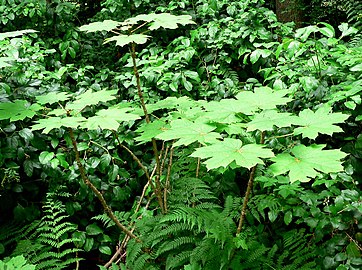Devil's club
| Devil's Club | |
|---|---|

| |
| Devil's club in Juneau, Alaska | |
| Scientific classification | |
| Kingdom: | Plantae |
| Clade: | Tracheophytes |
| Clade: | Angiosperms |
| Clade: | Eudicots |
| Clade: | Asterids |
| Order: | Apiales |
| Family: | Araliaceae |
| Genus: | Oplopanax |
| Species: | O. horridus
|
| Binomial name | |
| Oplopanax horridus | |
| Synonyms | |
|
Echinopanax horridum[1] | |
Devil's club or Devil's walking stick (Oplopanax horridus, Araliaceae; syn. Echinopanax horridus, Fatsia horrida)[2] is a large understory shrub native to the rainforests of the Pacific Northwest, but also disjunct on islands in Lake Superior. It is noted for its large palmate leaves and erect, woody stems covered in noxious and irritating spines. It is also known as Alaskan ginseng and similar names, although it is not a true ginseng.
Description
[edit]Devil's club generally grows to 1 to 1.5 metres (3+1⁄2 to 5 ft) tall. Some stands located in rainforest gullies or moist, undisturbed areas can reach heights of 3 to 5 m (10 to 16+1⁄2 ft) or more. The spines are found along the upper and lower surfaces of veins of its leaves as well as the stems. The leaves are spirally arranged on the stems, simple, palmately lobed with 5–13 lobes, 20 to 40 centimetres (8 to 15+1⁄2 in) across. The flowers are produced in dense umbels 10 to 20 cm (4 to 8 in) diameter, each flower small, with five greenish-white petals. The fruit is a small red drupe 4 to 7 millimetres (1⁄8 to 1⁄4 in) diameter.[2]
The plant is covered with brittle yellow spines that break off easily if the plants are handled or disturbed, and the entire plant has been described as having a "primordial" appearance. The plants are slow growing and take many years to reach seed-bearing maturity; this makes them very sensitive to human impact as they do not reproduce quickly.[citation needed]
Devil's club reproduces by forming clonal colonies by means of rhizomes. What can appear to be several different plants may actually have all been one plant originally, with the clones detaching themselves after becoming established by laying down roots.[3]
-
Spines on stem, Washington
-
Large leaves on the top of stems
-
Leaf in late summer
-
Flowers and bumblebees
-
Shiny red drupes in elongate clusters, Washington
Distribution and habitat
[edit]This species usually grows in moist, dense forest habitats, and is most abundant in old-growth conifer forests in the Pacific Northwest.[2] It is found from southcentral Alaska[4] south to Oregon, and eastward to western Alberta and Montana. Disjunct native populations also occur over 1,500 kilometres (930 miles) away in Lake Superior on Isle Royale and Passage Island, Michigan and Porphyry Island and Slate Island, Ontario.[5]
Uses
[edit]Traditionally, the charcoal from the stalks is still used to make ceremonial and protective face paints, and among the Ditidaht and neighboring groups, it was equally significant to red ochre as a symbolic link to the spirit world. Indigenous peoples such as the Tlingit and Haida have used the plant as traditional medicine for ailments such as adult-onset diabetes, as well as rheumatoid arthritis.[6]
The plant has been used ceremonially by the Tlingit, Tsimshian, and Haida people residing in Southeast Alaska and coastal British Columbia. A piece of Devil's club hung over a doorway is said to ward off evil. The plant is harvested and used in a variety of ways, most commonly as an oral tea in traditional settings, but also poultices and ointments.[7] Native Americans also dried and powdered the bark for use as a deodorant[8] and used the mashed berries to clean hair.[9]
Because devil's club is related to American ginseng, some people try to market the plant as an 'adaptogen'. The plant has been harvested for this purpose and sold widely as "Alaskan ginseng". Despite some morphological similarities between the araliaceous members Panax ('true' ginseng), Eleutherococcus senticosus ("Siberian ginseng") and devil's club, the different genera are chemically diverse.[citation needed]
Research
[edit]An in vitro study showed that extracts of devil's club might inhibit tuberculosis.[10] Another study suggested devil's club may reduce leukemia burden in mice engrafted with murine C1498 acute myeloid leukemia cells.[11]
References
[edit]- ^ Hulten, Eric (1968). Flora of Alaska and Neighboring Territories. Stanford University Press. ISBN 978-0-8047-0643-8.
- ^ a b c Pojar, Jim; Andy MacKinnon (1994). Plants of Coastal British Columbia. BC Ministry of Forests and Lone Pine Publishing. p. 82. ISBN 978-1-55105-042-3.
- ^ Trevor C. Lantz; Joseph A. Antos (2002). "Clonal expansion in the deciduous understory shrub, devil's club". Can. J. Bot. 80 (10): 1052–1062. doi:10.1139/b02-095. Archived from the original on 2012-07-07.
- ^ "Devil's Club".
- ^ "Oplopanax horridus". U.S. Forest Service. Retrieved 2022-08-06.
- ^ Turner, Nancy J. (May 1982). "Traditional Use of Devil's-Club (Oplopanax horridus; Araliaceae) by Native Peoples in Western North America" (PDF). J. Ethnobiol. Society of Ethnobiology. Retrieved 28 February 2013.
- ^ Levine, Ketzel Use of devil's club plant central to Tlingit culture National Public Radio Morning Edition, 8/11/2004
- ^ Whitney, Stephen (1985). Western Forests (The Audubon Society Nature Guides). New York: Knopf. p. 425. ISBN 0-394-73127-1.
- ^ Fagan, Damian (2019). Wildflowers of Oregon: A Field Guide to Over 400 Wildflowers, Trees, and Shrubs of the Coast, Cascades, and High Desert. Guilford, CT: FalconGuides. p. 23. ISBN 978-1-4930-3633-2. OCLC 1073035766.
- ^ Inui T, Wang Y, Deng S, Smith DC, Franzblau SG, Pauli GF (Jun 1, 2000). "Counter-current chromatography based analysis of synergy in an anti-tuberculosis ethnobotanical". Journal of Chromatography A. 1151 (1–2): 211–5. doi:10.1016/j.chroma.2007.01.127. PMC 2533621. PMID 17316661.
- ^ McGill; et al. (2014). "Extracts of Devil's Club (Oplopanax horridus) Exert Therapeutic Efficacy in Experimental Models of Acute Myeloid Leukemia". Phytotherapy Research. 28 (9): 1308–1314. doi:10.1002/ptr.5129. PMID 25340187. S2CID 25922076.
External links
[edit]- Michigan Natural Features Inventory -- Oplopanax horridus
- Edibility of Devil's Club: Visual identification and edible parts of Devil's Club.





